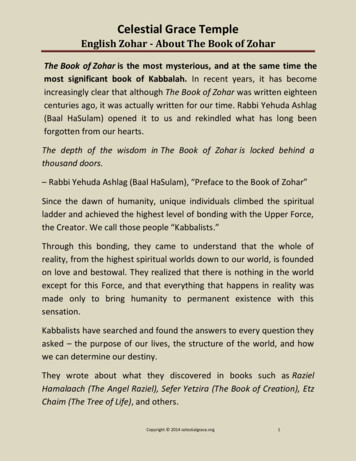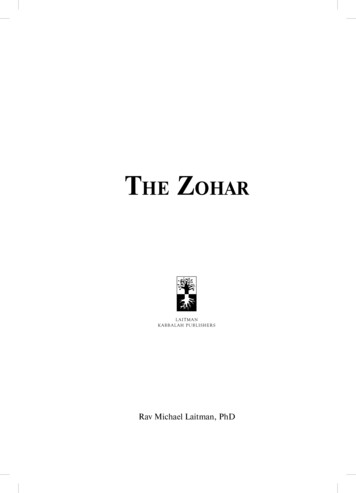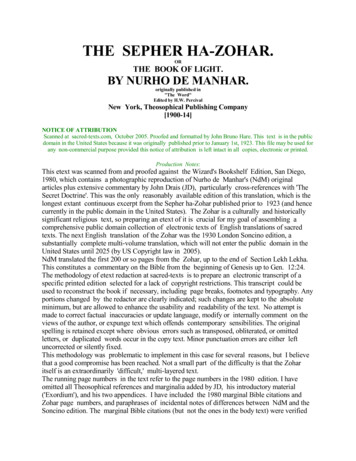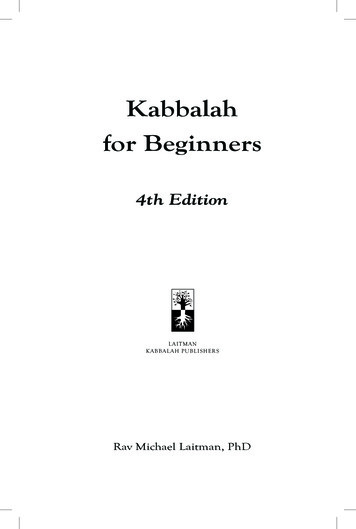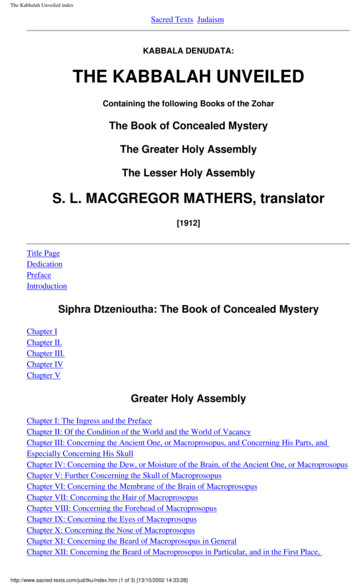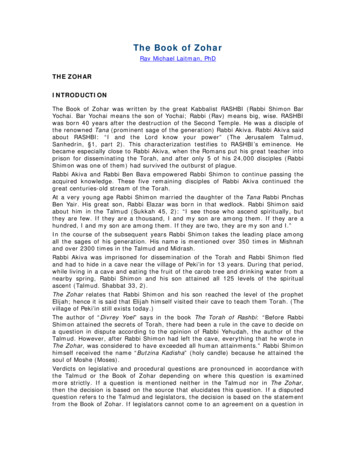
Transcription
The Book of ZoharRav Michael Laitman, PhDTHE ZOHARINTRODUCTIONThe Book of Zohar was written by the great Kabbalist RASHBI (Rabbi Shimon BarYochai. Bar Yochai means the son of Yochai; Rabbi (Rav) means big, wise. RASHBIwas born 40 years after the destruction of the Second Temple. He was a disciple ofthe renowned Tana (prominent sage of the generation) Rabbi Akiva. Rabbi Akiva saidabout RASHBI: “I and the Lord know your power” (The Jerusalem Talmud,Sanhedrin, §1, part 2). This characterization testifies to RASHBI’s eminence. Hebecame especially close to Rabbi Akiva, when the Romans put his great teacher intoprison for disseminating the Torah, and after only 5 of his 24,000 disciples (RabbiShimon was one of them) had survived the outburst of plague.Rabbi Akiva and Rabbi Ben Bava empowered Rabbi Shimon to continue passing theacquired knowledge. These five remaining disciples of Rabbi Akiva continued thegreat centuries-old stream of the Torah.At a very young age Rabbi Shimon married the daughter of the Tana Rabbi PinchasBen Yair. His great son, Rabbi Elazar was born in that wedlock. Rabbi Shimon saidabout him in the Talmud (Sukkah 45, 2): “I see those who ascend spiritually, butthey are few. If they are a thousand, I and my son are among them. If they are ahundred, I and my son are among them. If they are two, they are my son and I.”In the course of the subsequent years Rabbi Shimon takes the leading place amongall the sages of his generation. His name is mentioned over 350 times in Mishnahand over 2300 times in the Talmud and Midrash.Rabbi Akiva was imprisoned for dissemination of the Torah and Rabbi Shimon fledand had to hide in a cave near the village of Peki’in for 13 years. During that period,while living in a cave and eating the fruit of the carob tree and drinking water from anearby spring, Rabbi Shimon and his son attained all 125 levels of the spiritualascent (Talmud. Shabbat 33, 2).The Zohar relates that Rabbi Shimon and his son reached the level of the prophetElijah; hence it is said that Elijah himself visited their cave to teach them Torah. (Thevillage of Peki’in still exists today.)The author of “Divrey Yoel” says in the book The Torah of Rashbi: “Before RabbiShimon attained the secrets of Torah, there had been a rule in the cave to decide ona question in dispute according to the opinion of Rabbi Yehudah, the author of theTalmud. However, after Rabbi Shimon had left the cave, everything that he wrote inThe Zohar, was considered to have exceeded all human attainments.” Rabbi Shimonhimself received the name “Butzina Kadisha” (holy candle) because he attained thesoul of Moshe (Moses).Verdicts on legislative and procedural questions are pronounced in accordance withthe Talmud or the Book of Zohar depending on where this question is examinedmore strictly. If a question is mentioned neither in the Talmud nor in The Zohar,then the decision is based on the source that elucidates this question. If a disputedquestion refers to the Talmud and legislators, the decision is based on the statementfrom the Book of Zohar. If legislators cannot come to an agreement on a question in
dispute, the decision is also based on the opinion of The Zohar (See “Mishna Brura,”25, 42).The great follower of Rabbi Shimon, an heir (or next receiver) to his soul KabbalistARI points out in his books that his soul is the same soul of Rabbi Shimon and Moshe(the ARI. Sha’ar HaGilgulim, item 64). Rabbi Shimon received his soul to correct thesoul of Ichiya Ashiloni who “corrupted” Malchut. This happened in connection withthe sin of the King Irva’am and led to the transgression of all Israel. Hence, the soulof Rabbi Shimon appeared to correct Israel’s sins. The part of The Zohar entitled“Raya Mi’emna” (faithful guide) relates how Rabbi Shimon attained the soul ofMoshe, merged with it, and obtained the higher wisdom.The great Achida also says in his books Maranan and Rabanan and Kli Yakar(Malachim 2, 12) that RASHBI’s work lay in correction of Ichiya Ashiloni’s sin.Rabbi Shimon says in the Talmud (Sukkah 45, 2): “I can deliver the entire worldfrom judgment from the day of my birth to present day. If my son is with me, wecan deliver the entire world from judgment from the day when the world was createdto present day. And if Yotam Ben Aziyahu is with us, we can deliver the entire worldfrom judgment from the day the world was created until its end.” The book ofMalachim narrates about Yotam Ben Aziyahu (20, 15).After the verdict was lifted, Rabbi Shimon founded his yeshiva in the settlement ofTekoa and in the village of Meron, where he taught his disciples and wrote the Bookof Zohar. He revealed the knowledge that was forbidden to divulge from the timewhen Israel received the Torah (See Tikuney Zohar, Hakdamah, p.17).To write all the secrets of the Torah, Rabbi Shimon was obliged to relate them in asecret form. Hence, he asked his disciple Rabbi Abba to set out his thoughts.According to his soul’s property, Rabbi Abba could convey the spiritual knowledge ina secret, concealed form. “THIS IS BECAUSE THE BOOK OF ZOHAR MUST REMAINCONCEALED UNTIIL THE GENERATION OF MASHIACH’S COMING, SO THAT WITHTHE HELP OF THIS BOOK HUMANKIND WILL RETURN FROM ITS SPIRITUAL EXILE.”(The Ari. Sha’ar Hakdamot. Hakdamah, p.3). That is why Rabbi Abba wrote theteaching of Rabbi Shimon in Aramaic, which is the reverse side of Hebrew.The Ari writes in “Ma’amarey RASHBI” (p. 100) that the writing of The Zohar in asecret form was possible because the soul of Rabbi Abba originated from thesurrounding Light and not from the inner Light. Hence, he could relate the highestwisdom in a secret form as simple stories.(Rabbi Shimon lived around 80 years and passed away on the holiday of LAG BAOMER, the 18th day of the month Iyar, surrounded by his disciples and generallyrecognized. This day is celebrated as the holiday of Light. Rabbi Shimon’s body wasburied in a cave on Mount Meron. The body of his son Elazar is buried a few metersfrom him.)Like the subsequent compositions of the Ari and other Kabbalists (evidently such isthe lot of all true spiritual books), the Book of Zohar was concealed for 800 years ina cave near Meron, until an Arab found it and sold it in the market place as awrapping material.Part of the detached sheets fell into the hands of a wise man who recognized andappreciated the writings. After a long search, he found many sheets in refuse bins orbought them from spice vendors who had used the sheets of The Zohar to wrap theirmerchandise. The book (as we know it today) was compiled from the found sheets.For many centuries, from that time until today, this book has been a subject ofcontroversy. Philosophers, scientists, and other “wise men” continue arguing aboutit. The fact is that only a Kabbalist, meaning a person who ascends to a certain
spiritual level, attains what this book says. For others it looks as a collection ofstories or ancient philosophy, etc. Only the people who understand nothing in thisbook argue about it. Kabbalists clearly know one thing: the book of RASHBI is thegreatest source of the spiritual attainment that people in this world received from theCreator.Although the Book of Zohar was written in the 4th century, only Rabbi Y. Ashlagcould compose a full commentary on it in the 1930s and 1940s. The reason for theconcealment of The Zohar from the 4th to 11th century and the lack of a completecommentary on it for 16 centuries is explained in The Introduction to the Book ofZohar.Rabbi Y Ashlag called his commentary “Sulam” (ladder) because by studying it aperson can ascend the spiritual levels of attaining the Upper Worlds as one climbs aladder in our world. After the commentary of the Sulam appeared in print, Rabbi Y.Ashlag received the title “Baal HaSulam” as it is customary among the Torah sagesto call a person not by his name but according to his highest attainment.The Book of Zohar consists of:1. Hakdamat Sefer HaZohar – “The Introduction to the Book of Zohar.” This partincludes a number of articles that fully reveals the inner meaning of the Torah.2. Sefer HaZohar – The Book of Zohar. It is divided into parts and chapters inconformance with the weekly chapters of the Torah:The Book of Beresheet:Beresheet, Noach, Lech Lecha, Vayera, Chaiey Sarah,Toldot, Vayetze, Vayishlach, Vayeshev, Miketz, Vayigash, Vayichi.The Book of Shemot:Shemot, Vayera, Bo, Bashalach, Yitro, Mishpatim, Terumah(Safra de Tzniuta), Tetzaveh, Ki Tissa, Veyikahel, Pekudey.The Book of Vayikra:Vayikra, Tzav, Shmini, Tazria, Metzura, Acharey, Kedushim,Emor, BaHar, Vechukotay.The Book of Bamidbar:Bamidbar, Naso (Idra Raba), Baalotcha, Shlach Lecha,Korach, Chukat, Balak, Pinchas, Matot.The Book of Devarim:VeEtchanen, Ekev, Shoftim, Titze, Vayelech, Ha’azinu (IdraZuta).3. Zohar Hadash – “The New Zohar” – additions to the weekly chapters:Beresheet, Noach, Lech Lecha, Vayera, Vayetze, Vayeshev, Bashalach, Yitro,Teruma, Ki Titze, Tzav, Acharey, BaHar, Naso, Chukat, Balak, Matot, VeEtchanen, KiTitze, Ki Tavo.4. Additional books in the Book of Zohar that are not the commentary on theTorah:Idra Raba, Idra Zuta, Safra de Tzniuta, Raza de Razin, Tosefta, Raya Mi’emna,Ashmatot, Sitrey Torah, Sitrey Otiot, and Tikuney Zohar.5. “Midrash HaNe’elam” – the commentary on the writings: Song of Songs, Ruth,Lamentations, and on the Torah.As a result of the second restriction, Malchut rose to Baal HaSulam made thecommentary on the entire Zohar that reached us. His main commentaries in “TheIntroduction to the Book of Zohar” and the chapter “Bereshit” are related in thelanguage of man’s spiritual work. The most valuable articles for the science ofKabbalah are The Zohar, Idra Raba, Idra Zuta, and Safra de Tzniuta written in thelanguage of Kabbalah. Beside these articles, the rest of The Zohar is the Midrash.In its original form, the Book of Zohar written by Rabbi Abba 16 centuries ago wasnot divided into weekly chapters. Its volume was several times larger that what
reached us, and it expounded not only the Torah, but also 24 other books of theTanach (“Prophets” and “Writings”).Beside the Book of Zohar Rabbi Shimon’s book of Tikkunim has reached us. Itconsists of 70 commentaries on the first word of the Torah, BERESHIT, because itincludes everything.This book offers a semantic translation of The Zohar, “The Sulam” commentary ofRabbi Y. Ashlag and my explanations. It also contains the first part of the Book ofZohar, “Hakdamat Sefer HaZohar.”At the beginning of the text the semantic translation is given in bold script. TheSulam commentary and my explanations are given in regular script or italics becauseit turned out to be extremely difficult to separate my explanations from RabbiAshlag’s holy texts. The numbers at the beginning of paragraphs correspond to thenumbers of paragraphs in the Book of Zohar with “The Sulam” commentary, vol. 1.The reason for the interlacing of texts lies in the fact that in the first place we soughtways to explain the meaning of The Zohar simultaneously in several languages: ofKabbalah (Sefirot, Partzufim, Gematria, and worlds), of spiritual work (feelings), ofthe Torah (narrative) and of the Talmud (judicial).For an understanding of the book’s style, I recommend the reader to return to thetranslation of the original text after learning and mastering the commentary.The Book of Zohar, like the entire Torah, speaks only about man (creation) and hisrelationship with the Creator. The Torah gives names of our world to all man’s innerproperties: the aspiration to the Creator is called “Israel,” the aspiration to theselfish reception of pleasures is called “nations of the world.” There is no connectionwhatsoever between these names in the Torah and the Jews and gentiles in ourworld. Kabbalah appeals to MAN!The book contains articles commented in the language of Kabbalah and otherscommented in the language of sensations which the beginner understands better.The reader can begin studying the book from such articles as “Night of the Bride,”“Who rejoices on holidays” and others, although the complete study of The Zohar isbased on a consistent learning of the material. Kabbalah gradually enters a person’sheart as one’s consciousness gets used to it. It can be mastered only by repeatedlyreviewing the studied materialRav Michael Laitman, PhDTHE LIST OF ABBREVIATIONS AND EXPLANATIONSAA – the Partzuf of Hochma, the central initial Partzuf of the world of Atzilut fromwhich all the other Partzufim originate.Abba – Father - the Partzuf of HochmaIma – Mother - the Partzuf of BinaZA – son (with regard to AVI)Nukva, Malchut – Sefira or Partzuf that receives from all the preceding Partzufim.Malchut of the world of Atzilut is the sum of all created beings, all human souls.Hence, it is called Knesset Israel (the Assembly of Israel).Israel – the property of bestowal, altruism. This is the property of the Creator orBina. Israel consists of the words Isra – straight and El – the Creator. Thus, Israelmeans the property of aspiring to attain equivalency of form with the Creator. Thenotion of “Nations of the world” constitutes an aspiration to selfish reception ofpleasure. Naturally, these two properties are present in every person. Kabbalah is
the method to develop the property of Israel in a person with the purpose ofattaining the Creator in this life.Kli – egoistical desires and aspirations or egoism are not called Kli. Kli means thecorrected desires that are suitable for reception of the Light. These non-egoisticaldesires with a screen transform egoism into altruism.Vessel – the human heart that receives all sensations is called the vessel ofreception of sensations. The spiritual vessel, about which The Zohar speaksspecifically, is the desire to bestow upon the Creator. That is to give Him all my heartand desires, meaning that I agree with all my heart and desires to give up all ofmyself for His sake. Such a complete and true intention is called “Lishma” (for theCreator’s sake).Mitigation of a law’s restriction. Restriction is Malchut’s self-imposed ban onreception of the Light. This ban is lifted as a result of the correction of Malchut by theproperties of Bina.Zivug – this term is translated as a sexual union between a man and a woman inthis world. Since spiritual actions are absolutely detached from our notions, I havechosen to use the Hebrew word “Zivug” as it is more abstract to people who have noknowledge of Hebrew and thereby are less confused by associations. The spiritualZivug means an aspiration of the higher Partzuf (ZA – male part) to pass the Light(pleasure) to the lower one (Malchut – female part). Both desires are completelyselfless as in the example of the host and the guest.PBP – Panim be Panim, face to face. This is when Zachar (male Sefira) or Abba(father) passes Ohr Hochma to the female Sefira of Ima (mother) for subsequenttransfer to children (ZON). The same relationship of ABA (Achor be Achor – back toback) and PBP exist between their children (ZON – ZA and Malchut).ABA – Achor be Achor, back to back (pronounced as Ach be Ach). If the PartzufAbba has Ohr Hochma, but is unwilling to pass it on to the Partzuf Ima-Bina, and ifIma does not want to receive it, such a relationship between them is called back toback. The same relationship can exist between ZA and Malchut.Hesed – mercy, compassion, altruism, Ohr Hassadim (the Light of mercy,compassion, and altruism). It appears only within the Kli (desire) that wishes to giveselflessly and be similar to the Creator. This is the property of Sefira or Partzuf ofBina. Bina of the world AK (Adam Kadmon) is called SAG. Bina of the world of Atzilutis called Ima, supernal mother, YESHSUT, AVI, etc. The Light of Bina is the pleasureof being similar to the Creator’s properties; hence this Light (sensation) happens tobe the most reliable protection from impure forces. The Kli with the properties ofBina is unable to transgress because its sole desire is to bestow.KaHaB – Keter-Hochma-Bina. These are the first three Sefirot that form the Rosh(head) of the Partzuf. The head decides how much pleasure the Partzuf can acceptnot for its own sake but for the sake of the Creator. This Light descends from theRosh to the Guf (body).HaBaD – Hochma-Bina-Da’at. This is the same as Keter-Hochma-Bina (Rosh ofPartzuf). Sefira Da’at is not Sefira, but the request (called MAN) of ZON. This is the
appeal of ZON to Bina about the reception of Ohr Hochma from it. This prayer (MAN)of ZON rises to Bina and stimulates in Bina (Ima - mother) the desire to bestow uponher children, ZON. MAN in Bina is called Sefira Da’at. This is not a regular Sefira aswith the 10 Sefirot; rather, this is a request. However, to stress this state, we usethe name HBD instead of KHB.HaGaT – Hesed-Gevura-Tifferet. These are the Sefirot of the body that are similar tothe Sefirot of the head: Hesed is like Keter, Gevura is like Hochma, and Tifferet islike Bina. They are called GE of the body.NHYM – Netzah-Hod-Yesod-Malchut (pronounced as NeHYM). These Sefirot receivefrom the Sefirot of HaGaT (GE). Since they receive and have the will to receive, theyare called AHP of the body.GE – Galgalta-Eynaim (skull and eyes). The Sefirot Keter-Hochma-GAR de Bina donot have the will to receive. They wish only to bestow; hence they cannot becomeegoistical.NaRaN – Nefesh-Ruach-Neshama. This is the Light that fills the small Partzuf.Katnut (small state) means when the Partzuf has power (screen) only to bestow andnot receive. It is unable to receive for the sake of the Creator in defiance of itsdesire. In this case, the Partzuf has only Ohr Hassadim and no Ohr Hochma (theLight of Wisdom); hence it is called a small Partzuf without power and mind as achild in our world.AHP – Awzen-Hotem-Peh (ear-nose-mouth). The Sefirot ZAT de Bina-ZA-Malchuthave the will to receive; therefore, in the absence of a proper screen (resistance tothat desire) they become egoistical. The Partzuf without a screen on its AHP is calledKatan (small) and its state is called Katnut (small and incomplete, it is reminiscent ofa child in our world because it has no power (screen) and possesses only OhrHassadim and no Ohr Hochma).Gadlut – big state. The Partzuf with a screen (force of resistance to its egoisticalnature) can not only refrain from receiving, but can also receive not for its own sake(as in the example of the host and the guest). In this case the Partzuf fills all of itsdesires with the Lights of Hassadim and Hochma.1st Big State – Gadlut Aleph, the attainment of the Light of Neshama.2nd Big State – Gadlut Bet, the attainment of the Light of Haya.Ohr Hochma – the Light of wisdom. This Light fills the Kelim (desires) of reception.It comes only if a screen on altruistic reception is available.Ateret Yesod – the place of the covenant between Israel and the Creator. Malchutde Malchut that remains after circumcision of Orla (foreskin). This is the correctedpart of Malchut, its combination with the Sefira Yesod on which a Zivug can be madeduring 6000 years. This way it is possible to bring Malchut to the end of correction.After the 2nd restriction it is forbidden to make a Zivug on Malchut, but such a Zivugcan be made on the properties called Ateret Yesod which Malchut received from ZA.Just as the desires of Malchut are cut off, the foreskin is circumcised, and the desiresreceived from ZA called Ateret Yesod remain within Malchut. It can make a Zivugwith ZA on these desires and receive the Light of Hochma. Naturally, this is not thesame Light of Hochma that Malchut would receive if it were able to make a Zivug onits own desires (on itself), on its properties called the central point of creation,meaning truly egoistical desires. Malchut will be able to do that only after 6000years, at the end of correction. Before that happens, this place or these desires arecalled the sign of the covenant with the Creator.NaRaNHaY – Nefesh-Ruach-Neshama-Haya-Yechida. This Light fills the big Partzufconsisting of GE and AHP.
Light – pleasure, Ohr, the sensation of the Creator should always be interpreted asthe same notions because usually the word “Light” is used, but all of its synonymsare implied!Gematria – numerical value of a letter, or a combination of letters, a word. This is aspecial way of registering the spiritual information.Parsa – the division between the world of Atzilut and the worlds of BYA. It divides10 Sefirot into two parts: the Kelim of bestowal (GAR, KaHaB, or GE) and the Kelimof reception (ZON or Bina-ZA-Malchut) because Bina deliberately fell into ZA with thepurpose of correcting AHP. The Malchut that rose above Bina and standing underHochma is called Parsa and it separates GE from AHP.ZAT, ZAK – 7 Sefirot: H-G-T-N-H-Y-M.VAT, VAK – 6 Sefirot: H-G-T-N-H-Y.De – the preposition “of” in a possessive meaning. For example, Malchut de Atzilutmeans Malchut of the world of Atzilut.Garments – properties, desires, Kelim. Usually, this is said about the garments thatMalchut receives from Bina.Chupah– a wedding canopy under which a marriage ceremony takes place.Nartik – the covering of ZA; the same as Houppah.Adornments – the Light of Hassadim which Bina passes to Malchut. It correctsMalchut and enables it to receive the Light of Hochma in the Light of Hassadim.Orla – foreskin on the Sefira Yesod, in the place of Zivug between ZA and Malchut.It must be detached because during 6000 years it is impossible to make a Zivug(intention) on Malchut in the reception for the Creator’s sake. Only a Zivug on theunion of Malchut with ZA can be made. This is called Ateret Yesod, the part of theSefira Yesod that remains after cutting off Orla. A Zivug can be made on it during6000 years. Orla is Malchut de Malchut or the impure forces.Mother – Bina with regard to Malchut, daughter.Daughter - Malchut with regard to Bina, mother.Holy of holies – the Light of GAR or Neshama-Haya-Yechida.Question – the sensation of lack of the Light of Hochma in Malchut.Sela – rock or truth. The name of Malchut.Shechina – the sensation of the Creator’s appearance to those who attain Him.Malchut in the state of reception of the Light (the Creator) is called Shechina. This isa person’s sensation of the Creator. Shechina is where a person feels Him.Techum – the boundary that a person is forbidden to transcend on Sabbath.Techum Shabbat constitutes the maximal distance within which a person can moveduring Sabbath.Sigim – impure desires that exist within pure desires. Man’s work liesthem and the gradual correction of Sigim. The word Sigim comes fromthey appeared as a result of the breaking of the Kelim of the world ofrefer to the system of the Partzufim of SAG. The word “Sigim” foundKabbalah into the spoken Hebrew.in separatingSAG becauseNikudim thatits way fromSHACH – Shin-Chaf. 300 20 320 fragments of the broken vessel.RAPACH – Reish-Pey-Chet. 200 80 288 fragments of the broken vessel, which aperson can and must correct during 6000 years, i.e., by ascending 6000 steps of thespiritual ladder.Lev HaEven – Lev Lamed-Bet 30 2 32 fragments of the broken Malchut.These parts of Malchut cannot be corrected and made altruistic. However, one can
refrain from using these desires. Lev HaEven, which literally means “stony heart,” iscorrected during 6000 years (i.e., after the Creator Himself corrects 288 fragmentswithin man). It becomes completely altruistic and receives the name “Lev Basar”(living heart).Lo Lishma – not for the sake of the Creator. Since nothing but the Creator and manexists in creation, unless something is done “for the sake of the Creator,” it is done“for one’s self.” This is man’s egoistical intention.Lishma – for the sake of the Creator. Man’s selfless intention to act only to pleaseand bring joy to the Creator.4 angels that participate in creating man – 4 basic properties of nature: mercy –Hesed, justice – Tzedek, truth – Emet, and peace – Shalom.Land of Israel – Yetzira of this world. Yerushalaim is Ateret Yesod in Malchut.ORIGINAL NAMES AND THEIR EQUIVALENTS ACCEPTED IN THE ENGLISHTRANSLATIONORIGINAL NAMES AND THEIR EQUIVALENTS ACCEPTED IN THE ENGLISHTRANSLATION:Bat-Sheva- Bathsheba,Ovadia- Obadiah,Betzalel- Betzalel,Pinchas- Pinchas,Bil’am- Balaam,Rivka- Rebecca,Yirmiyahu- Jeremiah,Ruth- Ruth,Zachariah- Zechariah,Tamar- Tamar,Yitzchak- Isaac,Havvakuk - Habakkuk,Yechezkel- Ezekiel,Chagai- Haggai,Yeshayahu- Isaiah,Tzefania- Zephaniah,Yehoshua- Joshua,Hanoch- Eunuch,Yishmael- Ishmael,Tzur- Tyre,Ya’akov- Jacob,Shlomo- Solomon,Yehudah- Judah,Shmuel- Samuel,Yerushalaim- Jerusalem,Shet- Seth,Yosef- Joseph,Shimon- Simeon,Korach- Korach,Eden- Eden,Leah- Leah,Ezra- Ezra,Moshe- Moses,Eliyahu- Elijah,Micha- Micah,Elisha- Elisha,Nachum- Nahum,Esav- Esau,Nechemia- Nehemiah,Ester- Esther,Navuchadnetzar - Nebuchadnezzar, Noach- Noah
ORIGINAL TITLES AND THEIR EQUIVALENTS ACCEPTED IN THE ENGLISHTRANSLATION:Beresheet- Genesis,Shemot- Exodus,Bamidbar- Numbers,Shmueland 21 - Samueland 2,Devarim- Deuteronomy,ShirHaShirim- SongSongs,DivreyHaYamim- Chronicles,Shoftim- JudgesKohelet- Ecclesiastes,Tehilim- Psalms,1 - Kings 1 and2,Vayikra- Leviticus.Malachimand 2Mishley1of- ProverbsTHE EXAMPLE OF THE ORIGINAL TEXT OF THE ZOHARLITERAL TRANSLATION OF THE AFORECITED TEXT FROM ARAMAIC INTOENGLISH(The translation in the book is semantic and not literal)1. Rabbi Chizkiyah opened by saying, “It is written, as the rose amongst the thorns”.What is the rose? It is the Community of Israel. Because there is a rose; and there isa rose. Just as the rose among the thorns is tinged with red and white, so is theCommunity of Israel is affected by the qualities of judgment and mercy. Just as therose has thirteen petals, so the Community of Israel is surrounded by the thirteenattributes of mercy. However, Elokim thought here to reveal 13 words that surroundthe Community of Israel and guard it.2. After this, in order to bring out the five rigid leaves that surround the rose, it ismentioned another time in the passage. These five mean salvation. These are 5gates. And this secret is written about, “I will raise the cup of salvation.” This is the‘cup of benediction.’ The cup of benediction must rest on five fingers, and no more,just as the rose rests on five rigid leaves that represent the five fingers. This rose isthe cup of benediction. From the second to the third mention of the name Elokim,there are five words. From this point the Light was created and concealed andenclosed within that covenant that entered the rose and fructified it. This is referredto as a tree bearing fruit whose seed is within it and this seed really exists in theletter of the covenant.3. And just as the covenant is sown by forty-two conceptions from that same seed,so is the holy name of the creation sown.4. In the beginning, Rabbi Shimon opened by saying, the flower buds appeared onthe earth. “The flower buds” refer to the act of creation. They appeared on the earthon the third day, as it is written, “The earth brought forth.” Since then, they havebeen seen on the earth. The time of singing has come, and this is the fourth day,when the restriction came from the Light of Hassadim. The “voice of the turtle dove”refers to the fifth day, about which it is written, “Let the waters swarm,” so they canproduce living creatures. “It is heard” refers to the sixth day, on which it says, “Let
us make man,” and it is said, “We will do, and we will hear.” “In our land” refers tothe day of Shabbat, which represents the Land of Life.5. Another meaning is that these blossoms are the Patriarchs who entered thethoughts of the future world, where they were hidden. They secretly emerged fromthere and hid themselves in the true prophets. Joseph was born and they hid in him.When Joseph entered the Holy Land, he revealed their presence and then theyappeared on the earth and were seen there. And when are they seen? When therainbow is seen in the sky. Because when the rainbow is seen, then they appear. Andat that moment, the time of pruning has come. This is the period to annihilate thewicked from the world. But why were the wicked saved? Because the sprouts can beseen on the earth. If they had not appeared, they would not have remained onearth, and the world could not have existed.6. Who sustains the world and causes the Fathers to appear? It is the voices of thechildren who study the Torah. And these children save the world. In deference tothem, it is written, “We will make you pendants of gold”. This refers to the children,boys and young men, as is written, “And you shall make two Cherubs of gold.”7. In the beginning, Rabbi Elazar began by saying, “Lift up your eyes on high andsee. Who has created these things?” Lift up your eyes. To what place? To the placewhere all eyes depend on Him. And who is He that created these things? He is theopening of the eyes. And you should know that this is the concealed Atik where liesthe question: Who has created these? And who (MI) is He? He is called from theextremity of heaven on high, as everything belongs to Him. The question arisesbecause of Him, and He is concealed. He is called MI because beyond him there liesno question. Thus, the extremity of heaven is called MI.8. There is another extremity down below called MA (what). What is between MI andMA? The first one is concealed and is called MI. Therein lies a question because manhas asked and searched and inquired in order to understand and climb from onelevel to another, until he reached the highest level of all. After he had arrived there,he was asked: MA? (what?). What have you learned? What have you seen? Whathave you investigated, since everything is still concealed and hidden as before! Yeteverything is concealed as before.9. It is written on this secret subject, “What can I take to witness for you? What shallI compare with you?” The Temple was destroyed, and a voice came forth and said,“What shall I take to witness for you, and what shall compare with you?” The wordMA (what) shall witness to you each and every day since the ancient d
The Book of Zohar consists of: 1. Hakdamat Sefer HaZohar – “The Introduction to the Book of Zohar.” This part includes a number of articles that fully reveals the inner meaning of the Torah. 2. Sefer HaZohar – The Book of Zohar. It is divided into parts and chapt
